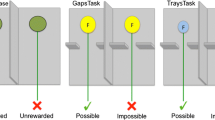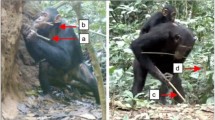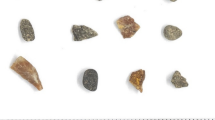Abstract
Tool use and the associated need to choose appropriate objects for a particular task are thought to have selected for specialized cognitive abilities such as means–end comprehension. Several studies on large-brained tool-using primates and birds have demonstrated understanding of causal relationships to some extent. However, a comprehensive appraisal of this hypothesis requires testing for means–end comprehension also in non-tool-users as well as in small-brained tool users. Moreover, the results of captive studies do not answer the question whether such cognitive abilities are relevant to an animal in its natural environment. Here I presented wild banded mongooses Mungos mungo, small-brained carnivores that regularly use anvils to open food items with a hard shell, with a transfer test involving novel anvil objects. I found no evidence for means–end comprehension or a heuristic strategy used for anvil choice in this species. Instead, recognition of suitable anvils appears to be learned by trial and error separately for different categories of anvils. These data suggest that, at least for the anvil-choice task investigated here, the need to choose suitable objects has not selected for specialized cognitive abilities in banded mongooses, a finding that may extend to a large range of proto-tool users. Furthermore, this study adds to growing evidence that animals subjected to the selection pressures and trade-offs of their natural environment may get by with cognitively more simple strategies than sometimes suggested by captive studies or plausibility arguments.


Similar content being viewed by others
References
Bania AE, Harris S, Kinsley HR, Boysen ST (2009) Constructive and deconstructive tool modification by chimpanzees (Pan troglodytes). Anim Cogn 12:85–95
Bates D, Maechler M, Dai B (2008) lme4: Linear mixed-effects models using S4 classes. R package version 0.999375-27. http://lme4.r-forge.r-project.org
Beck BB (1980) Animal tool behaviour. Garland STPM Press, New York
Blaisdell AP, Sawa K, Leising KJ, Waldmann MR (2006) Causal reasoning in rats. Science 311:1020–1022
Boesch C, Boesch H (1990) Tool use and tool making in wild chimpanzees. Folia Primatol 54:86–99
Byrne RW (1997) The technical intelligence hypothesis: an additional evolutionary stimulus to intelligence? In: Whiten A, Byrne RW (eds) Machiavellian intelligence. Vol 2: extensions an evaluations. Cambridge University Press, Cambridge, pp 289–311
Cant MA (2000) Social control of reproduction in banded mongooses. Anim Behav 59:147–158
Chappell J, Kacelnik A (2002) Tool selectivity in a non-primate, the New Caledonian crow (Corvus moneduloides). Anim Cogn 5:71–78
Chappell J, Kacelnik A (2004) Selection of tool diameter by New Caledonian crows Corvus moneduloides. Anim Cogn 7:121–127
Dufour V, Sterck EHM (2008) Chimpanzees fail to plan in an exchange task but succeed in a tool-using procedure. Behav Process 79:19–27
Fujita K, Kuroshima H, Asai S (2003) How do tufted capuchin monkeys (Cebus apella) understand causality involved in tool use? J Exp Psychol Anim Behav Process 29:233–242
Gajdon GK, Fijn N, Huber L (2004) Testing social learning in a wild mountain parrot, the kea (Nestor notabilis). Learn Behav 32:62–71
Halsey LG, Bezerra BM, Souto AS (2006) Can wild common marmosets (Callithrix jacchus) solve the parallel strings task? Anim Cogn 9:229–233
Hauser M, Spaulding B (2006) Wild rhesus monkeys generate causal inferences about possible and impossible physical transformations in the absence of experience. Proc Natl Acad Sci USA 103:7181–7185
Heinrich B, Bugnyar T (2005) Testing problem solving in ravens: string-pulling to reach food. Ethology 111:962–976
Herrmann E, Wobber V, Call J (2008) Great apes’ (Pan troglodytes, Pan paniscus, Gorilla gorilla, Pongo pygmaeus) understanding of tool functional properties after limited experience. J Comp Psychol 122:220–230
Holzhaider JC, Hunt GR, Campbell VM, Gray RD (2008) Do wild New Caledonian crows (Corvus moneduloides) attend to the functional properties of their tools? Anim Cogn 11:243–254
Huber L, Gajdon GK (2006) Technical intelligence in animals: the kea model. Anim Cogn 9:295–305
Hunt GR (1996) Manufacture and use of hook-tools by New Caledonian crows. Nature 379:249–251
Hunt GR, Rutledge RB, Gray RD (2006) The right tool for the job: what strategies do wild New Caledonian crows use? Anim Cogn 9:307–316
Kenward B, Weir AAS, Rutz C, Kacelnik A (2005) Tool manufacture by naive juvenile crows. Nature 433:121
Lefebvre L, Nicolakakis N, Boire D (2002) Tools and brains in birds. Behaviour 139:939–973
Mendes N, Hanus D, Call J (2007) Raising the level: orangutans use water as a tool. Biol Lett 3:453–455
Mulcahy NJ, Call J (2006) Apes save tools for future use. Science 312:1038–1040
O’Connell S, Dunbar RIM (2005) The perception of causality in chimpanzees (Pan spp.). Anim Cogn 8:60–66
Osvath M, Osvath H (2008) Chimpanzee (Pan troglodytes) and orangutan (Pongo abelii) forethought: self-control and pre-experience in the face of future tool use. Anim Cogn 11:661–674
Penn DC, Povinelli DJ (2007) Causal cognition in human and nonhuman animals: a comparative, critical review. Annu Rev Psychol 58:97–118
Pérez-Barbería FJ, Shultz S, Dunbar RIM (2007) Evidence for coevolution of sociality and relative brain size in three orders of mammals. Evolution 61:2811–2821
R Development Core Team (2008) R: a language and environment for statistical computing. R Foundation for Statistical Computing, Vienna, Austria. http://www.R-project.org
Santos LR, Pearson HM, Spaepen GM, Tsao F, Hauser MD (2006) Probing the limits of tool competence: experiments with two non-tool-using species (Cercopithecus aethiops and Saguinus oedipus). Anim Cogn 9:94–109
Sanz C, Morgan D, Gulick S (2004) New insights into chimpanzees, tools, and termites from the Congo Basin. Am Nat 164:567–581
Sanz C, Call J, Morgan D (2009) Design complexity in termite-fishing tools of chimpanzees (Pan troglodytes). Biol Lett 5:293–296
Seed AM, Tebbich S, Emery NJ, Clayton NS (2006) Investigating physical cognition in rooks, Corvus frugilegus. Curr Biol 16:697–701
Seed AM, Call J, Emery NJ, Clayton NS (2009) Chimpanzees solve the trap problem when the confound of tool-use is removed. J Exp Psychol 35:23–34
St Amant R, Horton TE (2008) Revisiting the definition of animal tool use. Anim Behav 75:1199–1208
Taylor AH, Hunt GR, Medina FS, Gray RD (2009) Do New Caledonian crows solve physical problems through causal reasoning? Proc R Soc Lond B 276:247–254
Visalberghi E, Fragaszy DM (2006) What is challenging about tool use? The capuchin’s perspective. In: Wasserman EA, Zentall TR (eds) Comparative cognition. Experimental explorations of animal intelligence. Oxford University Press, Oxford, pp 529–552
Visalberghi E, Tomasello M (1998) Primate causal understanding in the physical and psychological domains. Behav Process 42:189–203
Visalberghi E, Fragaszy DM, Savage-Rumbaugh S (1995) Performance in a tool-using task by common chimpanzees (Pan troglodytes), bonobos (Pan paniscus), an orangutan (Pongo pygmaeus), and capuchin monkeys (Cebus apella). J Comp Psychol 109:52–60
Visalberghi E, Addessi E, Truppa V, Spagnoletti N, Ottoni E, Izar P, Fragaszy D (2009) Selection of effective stone tools by wild bearded capuchin monkeys. Curr Biol 19:213–217
Acknowledgments
I am grateful to Uganda Wildlife Authority and Uganda National Council for Science and Technology for permission to work in Queen Elizabeth National Park. Mike Cant provided access to the study population and valuable logistical support. Kenneth Mwesige helped with data collection. I am also grateful to Mike Cant and Sarah Hodge and four anonymous reviewers for helpful comments on an earlier draft of the manuscript. During this study, the author was funded by the Swiss National Science Foundation (PBZHA-121022). Additional funding for field expenses was provided by the Janggen-Pöhn Stiftung and the Basler Stiftung für biologische Forschung, which is gratefully acknowledged.
Author information
Authors and Affiliations
Corresponding author
Electronic supplementary material
Below is the link to the electronic supplementary material.
Supplementary video 1: Mongoose approaching the food item via the unsuitable anvil and smashing the object 14 times unsuccessfully on the unsuitable anvil before abandoning it (MPG 6040 kb)
Supplementary video 2: Mongoose approaching the food item through the middle and opening it after 6 smashing attempts on the suitable anvil (MPG 2566 kb)
Rights and permissions
About this article
Cite this article
Müller, C.A. Do anvil-using banded mongooses understand means–end relationships? A field experiment. Anim Cogn 13, 325–330 (2010). https://doi.org/10.1007/s10071-009-0281-5
Received:
Revised:
Accepted:
Published:
Issue Date:
DOI: https://doi.org/10.1007/s10071-009-0281-5




